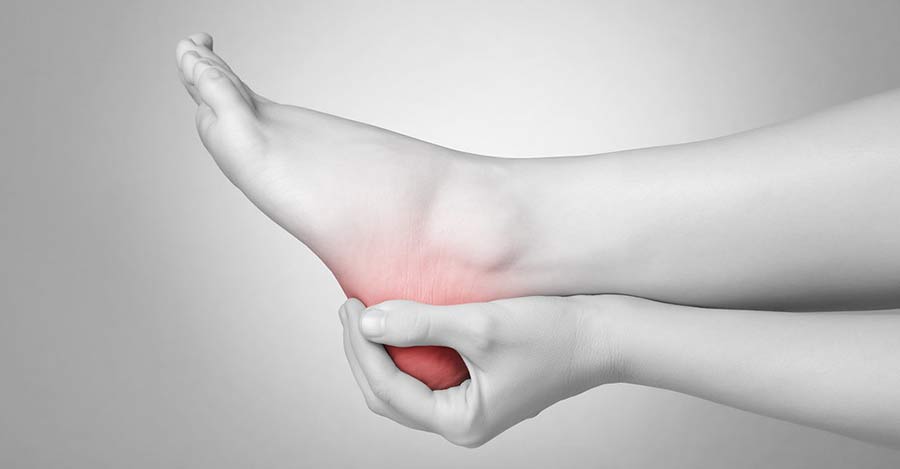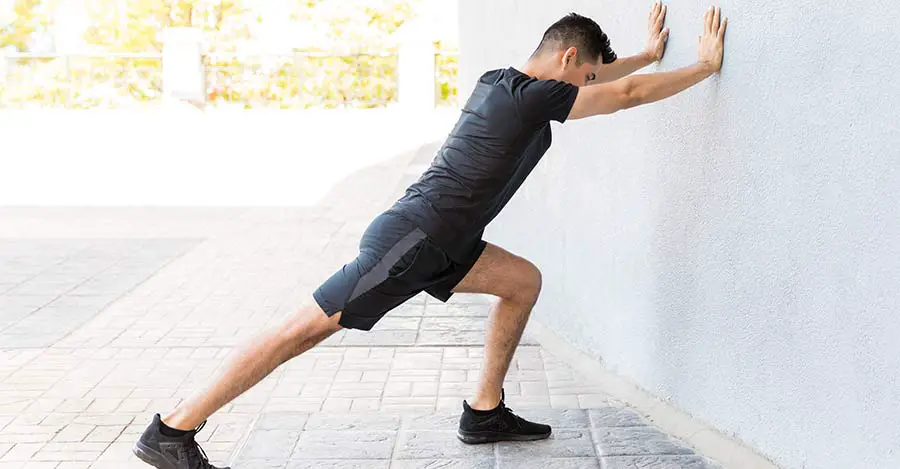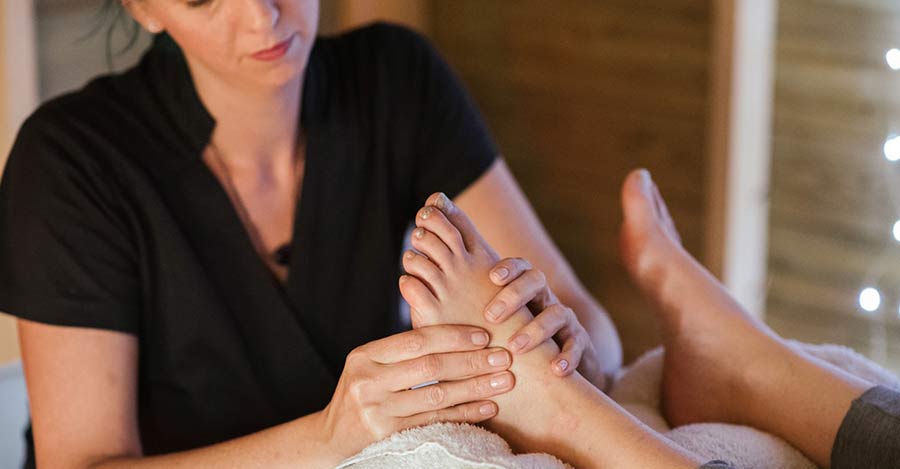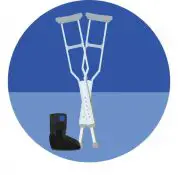Will Crutches Help Plantar Fasciitis?
Do you have plantar fasciitis? If so, you are likely wondering if crutches will help you manage your condition. Plantar fasciitis is painful and is often an exasperating condition. Yet, with mobility aids and the correct treatment, it can be manageable.
In this article, we will talk about everything to know about this injury. We will also look at if crutches will assist you.
What Is Plantar Fasciitis?

Plantar fasciitis is the most common cause of heel pain. It is also a common complaint seen by orthopedics. People with plantar fasciitis will experience pain at the bottom of their heels. To understand what plantar fasciitis is, you need first to know what the plantar fascia is.
The plantar fascia is a thick and weblike ligament found in the arch of the foot. This ligament runs from the ball of one’s foot through to the bottom of one’s heel. The plantar fascia ligament connects your heel to the front of your foot. This thick and weblike ligament acts as a shock absorber while supporting the arch of your foot which helps you run and walk.
Plantar fasciitis occurs when your plantar fascia ligaments experience wear and tear. This wear and tear occur through daily activities and tasks. When you are placing a lot of pressure on your feet, you are straining this weblike ligament. Excessive strain causes it to become inflamed, which leads to plantar fasciitis. This inflammation is what makes people experience heel stiffness and pain.
The Causes Of Plantar Fasciitis
It is still unclear what is the primary cause of plantar fasciitis. But some contributing factors make developing the condition more likely. We have listed a few common factors that lead to a person developing plantar fasciitis.
- Being overweight or obese.
- Having high arches or flat feet.
- Being an older adult between the ages of 40 and 60.
- Exercising on hard surfaces.
- Participating in high-intensity and high-impact sports like tennis and running.
- Those with jobs that need them to be on their feet constantly.
- Incorrect footwear or ill-fitting footwear.
- Those with tight Achilles tendons and calf muscles.
- New or sudden involvement in strenuous activity over a short timeframe.
The Symptoms Of Plantar Fasciitis

The primary symptom associated with those who have plantar fasciitis is heel pain. Another symptom seen with those who have this condition is pain felt at the bottom of the mid-foot area. Generally, plantar fasciitis will affect a single foot, but it can affect both feet in some cases.
The pain felt with plantar fasciitis is usually dull, sharp, or stabbing. This pain will arise gradually over an unspecified amount of time. Moreover, some will experience an ache or burning sensation at the bottom of their feet. This pain will extend outward from the heel.
Those with plantar fasciitis have said that the heel pain is more intense in the early morning. Others have stated that the pain is worse after a prolonged period of physical activity.
The pain felt with plantar fasciitis can come and go. This makes it easy to ignore without further evaluating the injury. If left untreated, it could worsen, and you could need to get surgery for this condition. If you feel sharp heel pain and suspect you have plantar fasciitis, you can visit your doctor. A doctor can determine if you are suffering from this condition.
The Diagnosis Of Plantar Fasciitis

For a doctor to diagnose if you have plantar fasciitis, they will need to conduct a physical exam. This exam will involve a doctor checking your foot for tenderness and pain. They will touch your foot to find the exact location of the pain you feel.
The doctor will do this to make sure that your heel pain is not the result of a different foot injury or condition. Sometimes to confirm a diagnosis, a doctor will need you to go for an X-ray or MRI scan. By doing this, they can rule out other foot conditions and injuries.
Usually, during the exam, a doctor will also ask you to flex your foot. When you do this, they will push on the plantar fascia ligament. They do this to double-check that the pain you are feeling is coming from this ligament. Additionally, they will also look to see if your foot and heel have any inflammation and swelling.
When you go to your doctor to confirm whether you have plantar fasciitis, they will do the following:
- Check your muscle tone.
- Check the reflexes in your foot.
- Check your balance.
- Check your coordination.
- Check your sense of touch.
Treatments For Plantar Fasciitis
Very few cases of plantar fasciitis need surgery. There are many different treatments available for those suffering from this condition.
According to orthopedic specialists, conservative treatment is the best route to take. Around 70% of people who make use of the treatments we mention below will experience pain relief. They will also manage their condition better.
Rest and Crutches

The simplest treatment for those who have a plantar fasciitis injury is to rest and use crutches. With this type of injury, you should use crutches for one to three weeks to keep your weight off the injury. A weight reduction will ease the pressure on the plantar fascia ligament. Thus this reduces pain and symptoms such as swelling and redness.
Ice
Along with rest and using a mobility aid like crutches, you should use ice. Up to four times a day, you should roll your foot over a frozen water bottle for twenty minutes at a time. By doing this, you will reduce inflammation and swelling.
Medication
Some anti-inflammatory medications can help treat chronic pain. Ibuprofen and Advil reduce pain and inflammation associated with plantar fasciitis injuries. Yet, these medications aren’t as efficient at helping relieve acute pain.
Proper Footwear
One of the very best treatments for plantar fasciitis is proper footwear. If you wear footwear that is comfortable and supportive, you will minimize the pain you feel. Your injury will also have a higher likelihood of healing.
Additionally, when looking for the correct footwear, ensure you know your foot shape. Your foot shape can affect what footwear is deemed suitable for you. In most instances, it’s best to stay away from high heels and flat shoes if you have plantar fasciitis.
Stretching
Stretching exercises are one of the best treatment methods for plantar fasciitis. There is a broad range of exercises you can take part in to help manage your pain and recover faster.
Toe stretches
Two to Four times a day; you need to do toe stretches. These stretches are done by pulling your big toe towards your ankle. Once you do this, you need to keep your big toe in this position for 30 to 45 seconds at a time.
Calf stretches

One to two times a day, you should do calf stretches. You will need to situate yourself near a wall and place your hands against a wall with your palms open. Once you have done this, move the leg with the injured heel backward until you feel the tension in your foot. Plant your heel on the ground and bring your knee forward. You will need to do this for two minutes at a time.
Arch stretches
A few times every day, you can do arch stretches. You will do this exercise by placing a rubber roller or water bottle under your foot. Once the roller is under your foot, you will roll your foot over it for several minutes at a time.
Band or towel stretches
Two to four times daily; you can complete band or towel stretches. To do this exercise, sit on the floor and wrap a towel or band around your foot. Once you have done that, pull the towel, and stretch your foot. You need to do this for thirty-second intervals.
Cortisone Injections

A reliable treatment option for those with plantar fasciitis is cortisone injections. Usually, a numbing agent is mixed with cortisone and injected at the point of pain. This injection relieves the pain felt when you first wake up. It also helps with pain felt after participating in exercises or daily activities.
Cortisone injections are reliable for reducing inflammation. Yet, when injected into the plantar fascia, they can cause chronic pain. They can also cause flat feet and a rupturing of the plantar fascia. This usually only happens if cortisone is used as a long-term treatment.
Athletic Tape
One of the most accessible treatment methods is to wrap your foot with athletic tape. The tape used to treat this condition is usually made from cotton and breathable.
If you have this type of injury, you can buy zinc oxide tape. With this tape, you can wrap your foot securely, which stabilizes the injury. Additionally, the wrapping won’t limit your movability too much.
Shoe Inserts
Another reliable treatment for plantar fasciitis is shoe inserts. Medical shoe inserts are often affordable and easy to use. You will use an arch insert to stabilize your foot. Stabilizing your foot will reduce the pain and inflammation.
Night Splints
Many people sleep with their feet angled down. This is a problem for those who have plantar fasciitis. Luckily there is a treatment that will ensure you stabilize your foot and reduce pain. This treatment is night splints. These are devices that keep the foot affected by plantar fasciitis at a 90-degree angle. Keeping your foot at this angle helps with recovery.
Heel Cups
Heel cups are often placed in shoes to help stabilize and support a foot and heel. They work well for plantar fasciitis injuries. Often a correctly set heel cup will help with recovery. It will also ensure your foot is perfectly in alignment, which helps reduce pain.
Physical Therapy
If you are struggling to heal your plantar fasciitis injury on your own, you can hire a qualified physical therapist. A professional physical therapist can help by creating a treatment and exercise program.
The treatments a physical therapist could use are cold therapy and massages. Additionally, one could also use ultrasounds, contrast baths, and extracorporeal shockwave therapy.
Surgical Treatment For Plantar Fasciitis

In some instances, non-surgical treatments for plantar fasciitis don’t work. In general, 5 out of every 100 patients need surgery. Yet, surgery is always seen as a last resort. Surgery will be an option if your plantar fasciitis injury has not healed within 12 months. If this is the case with you and your doctor has decided that you need surgery, there are usually two options.
It’s important to note that there is some risk involved if you opt to have one of the surgeries available. Some people have had nerve damage, while others experience no pain relief.
A common surgery for this type of injury is called plantar fascial release. A doctor will cut a part of your plantar fascia ligament around your heel pad during this surgery. When the 3 cm cut is made, it will release the tension in your heel and reduce the swelling around the affected area. Sometimes this surgery is done as an open surgery. Other times, it is done endoscopically.
The other surgical operation is called a gastrocnemius recession. During this operation, a person’s calf muscle is lengthened. This increases motion in the affected ankle. As with the other surgery, this one can be performed as an open surgery or endoscopically.
Recovering From Plantar Fasciitis Surgery
The recovery time for those who have had surgery for their plantar fasciitis injury is six weeks. During these six weeks, those who have had surgery will need to keep their weight off the healing foot. Using crutches or other mobility aids is often the best way to do this. Yet, if you don’t want to use traditional crutches, you can use a hands-free crutch or a knee scooter.
Using crutches will ensure you give your heel a chance to heal correctly. It will also minimize your chances of re-injuring yourself. Crutches take the pressure off your foot. This helps reduce pain and decrease inflammation and swelling.
10 Tips For Preventing Plantar Fasciitis
Are you fortunate enough not to have had a plantar fasciitis injury? Or have you had the injury in the past and would like not to get it again? You can take steps to prevent developing this condition. Below are ten of the best preventative tips to help reduce the likelihood of you getting this injury.
Warm-Up
Before beginning to exercise or take part in a sporting activity, warm up first. Warming up and stretching your muscles prepares your feet and ankles to absorb shock. This helps prevent plantar fasciitis injuries.
Have A Healthy Weight

Try to maintain a healthy weight. When you carry a lot of excess weight, you place incredible strain on your ankles, feet, and arches. This often leads to plantar fasciitis injuries. Maintaining a healthy weight ensures that you keep unnecessary pressure off your heels.
Roll Your Ligaments
When you have finished a high-impact workout, roll your ligaments. You can do this as part of your cooldown exercises. Simply roll your feet one at a time back and forth over a frozen water bottle or dumbbell. As we saw earlier, this method helps with treating a plantar fasciitis injury. Yet, it can also help prevent one.
Ensure You Run On Soft Surfaces

Do you take part in a lot of physical activity? If so, you should make sure to run on soft surfaces. Running on soft surfaces will reduce the impact your foot absorbs. This will ensure less strain is put on your plantar fasciitis ligaments. Thus preventing inflammation and injury.
Wear Proper Footwear
The correct footwear is vital. The shoes you wear can impact whether you will prevent plantar fasciitis injuries. You need to make sure that you wear comfortable yet supportive footwear. Replace your running shoes every 400 to 500 miles. Shoes will not support your feet correctly after this distance.
Know Your Fitness Limits
Always be aware of your limits. If you want to prevent developing a plantar fasciitis injury, be mindful of your fitness limits. Pay attention to your body signals, and don’t ignore any red flags. Additionally, when you are increasing your exercise limits, do it slowly and healthily.
Strength Training

Strength training is known to prevent many foot and ankle injuries. When you strengthen your midfoot muscles, you will have more support. This will prevent you from injuring your heel and getting a plantar fasciitis injury.
Stay Active
Having an active lifestyle is crucial. An active lifestyle ensures your muscles and ligaments are in peak physical health. This prevents many different injuries, including plantar fasciitis.
Have Regular Foot Massages

Massages matter. Having regular foot massages can prevent you from getting a plantar fasciitis injury. Frequent massages will ensure your foot stays supple. They also make sure that you have an excellent range of mobility.
Final Words
Plantar fasciitis injuries are often painful and difficult to identify. With this article’s help and a doctor’s knowledge, you can know if you have this type of injury. There are, luckily, many different treatment options for plantar fasciitis injuries.
Crutches, physiotherapy, and stretches are clearly crucial. They are particularly efficient at treating this type of heel condition. Fortunately, most people will heal with nonsurgical treatment options.
Yet, the two surgical treatment options we mentioned are also effective. They help relieve pain and fasten a more permanent recovery. Preventative measures will also reduce the chance of you ever having this type of injury. Try to follow the advice in this article and seek medical care. You will be a step closer to managing your pain and making a full recovery if you do.





